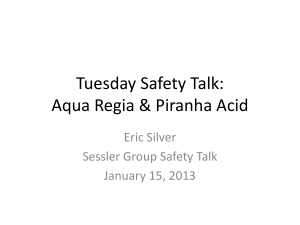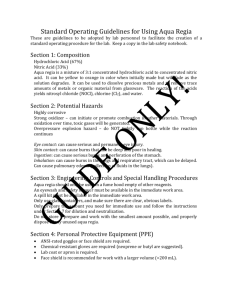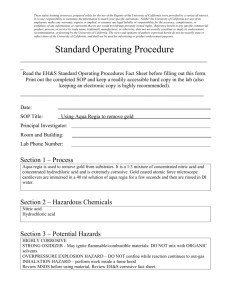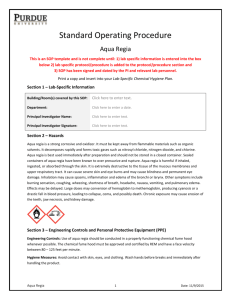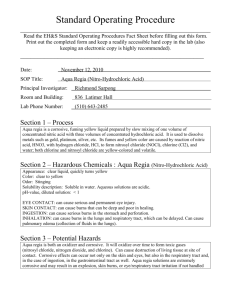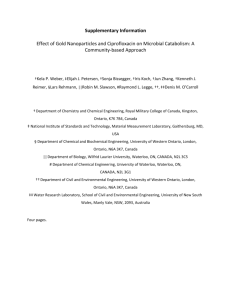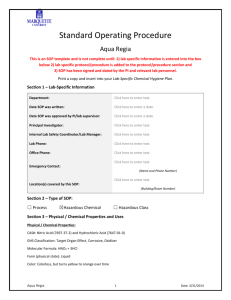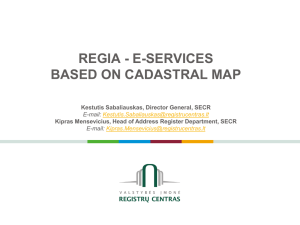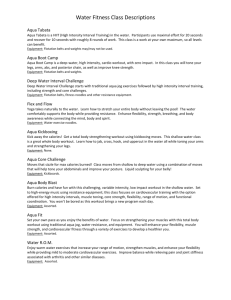Aqua Regia SOP: Safe Handling & Disposal Guide
advertisement
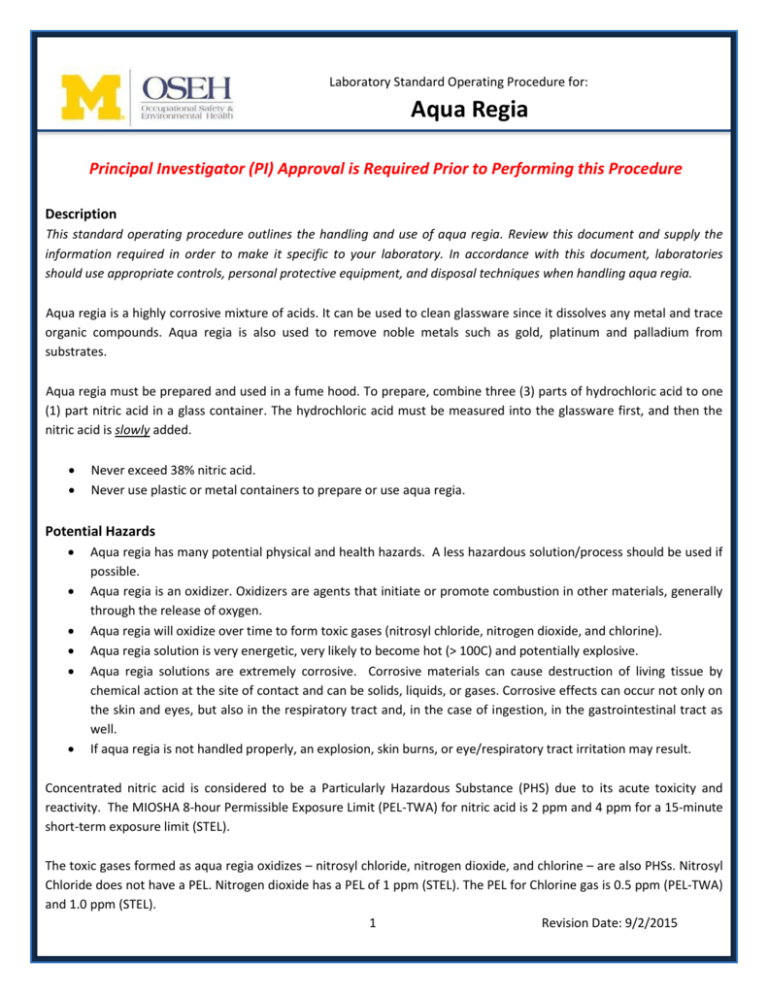
Laboratory Standard Operating Procedure for: Aqua Regia Principal Investigator (PI) Approval is Required Prior to Performing this Procedure Description This standard operating procedure outlines the handling and use of aqua regia. Review this document and supply the information required in order to make it specific to your laboratory. In accordance with this document, laboratories should use appropriate controls, personal protective equipment, and disposal techniques when handling aqua regia. Aqua regia is a highly corrosive mixture of acids. It can be used to clean glassware since it dissolves any metal and trace organic compounds. Aqua regia is also used to remove noble metals such as gold, platinum and palladium from substrates. Aqua regia must be prepared and used in a fume hood. To prepare, combine three (3) parts of hydrochloric acid to one (1) part nitric acid in a glass container. The hydrochloric acid must be measured into the glassware first, and then the nitric acid is slowly added. Never exceed 38% nitric acid. Never use plastic or metal containers to prepare or use aqua regia. Potential Hazards Aqua regia has many potential physical and health hazards. A less hazardous solution/process should be used if possible. Aqua regia is an oxidizer. Oxidizers are agents that initiate or promote combustion in other materials, generally through the release of oxygen. Aqua regia will oxidize over time to form toxic gases (nitrosyl chloride, nitrogen dioxide, and chlorine). Aqua regia solution is very energetic, very likely to become hot (> 100C) and potentially explosive. Aqua regia solutions are extremely corrosive. Corrosive materials can cause destruction of living tissue by chemical action at the site of contact and can be solids, liquids, or gases. Corrosive effects can occur not only on the skin and eyes, but also in the respiratory tract and, in the case of ingestion, in the gastrointestinal tract as well. If aqua regia is not handled properly, an explosion, skin burns, or eye/respiratory tract irritation may result. Concentrated nitric acid is considered to be a Particularly Hazardous Substance (PHS) due to its acute toxicity and reactivity. The MIOSHA 8-hour Permissible Exposure Limit (PEL-TWA) for nitric acid is 2 ppm and 4 ppm for a 15-minute short-term exposure limit (STEL). The toxic gases formed as aqua regia oxidizes – nitrosyl chloride, nitrogen dioxide, and chlorine – are also PHSs. Nitrosyl Chloride does not have a PEL. Nitrogen dioxide has a PEL of 1 ppm (STEL). The PEL for Chlorine gas is 0.5 ppm (PEL-TWA) and 1.0 ppm (STEL). 1 Revision Date: 9/2/2015 Engineering Controls An eyewash and safety shower must be available in the immediate work area for any work with aqua regia. When working with aqua regia, always work in a clean fume hood that contains NO organic material and keep the sash down while reactions are in progress. Work Practice Controls Set up a designated area for storage and work with aqua regia. Only prepare the amount you need for immediate use and follow the instructions for dilution and neutralization of unused solution. Work with the smallest practicable amount of aqua regia needed to perform your task. Never put aqua regia in a closed vessel; evolved gases will cause a pressure build-up and possible explosion. Never take aqua regia out of the fume hood. Once work with aqua regia is complete, wipe down the area with a soap and water solution. When working with aqua regia you must have specific HazMat absorbent pads or pillows that can be used on nitric acid, and these must be available in the immediate work area. These absorbent pads will be needed for clean-up in case of a small spill inside of the fume hood. Protective Equipment (PPE) Goggles, lab coat, chemical-resistant gloves (18 mil neoprene, Silver Shield, or any other glove rated to protect against hydrochloric AND nitric acid). Face shield and acid-resistant apron are recommended if working with a larger volume (>200ml). Transportation and Storage Never store aqua regia for later use; only make enough for immediate use. Never put aqua regia in an organic solvent cabinet; it is a strong oxidizer and incompatible with organic chemicals/solvents and any reducing agents. Never put a container of aqua regia near flammables or combustibles. Ensure primary and secondary containment is free from organic chemicals/solvents. Waste Disposal Disposal: Obtain piranha waste bottles and piranha venting caps from OSEH Hazardous Materials Management (HMM) at 763-4568. Be sure the waste bottles and caps are present in the lab before you prepare any aqua regia. Prior to adding any waste to the bottle, place a completed hazardous waste label on it. Be sure to put the accumulation start date on the label when you begin adding waste. Exposures/Unintended Contact If the employee is in need of emergency medical attention, call 911 immediately. For an actual chemical exposure/injury: 2 Flush exposed eyes or skin with water for at least 15 minutes, then seek medical attention (see below). Note: In case of inhalation, symptoms may be delayed up to 24 hours If swallowed, DO NOT INDUCE VOMITING. Never give anything by mouth to an unconscious person. Wash mouth with water, give plenty of water slowly to drink and obtain urgent medical attention. Contact OSEH for advice on symptoms of chemical exposure, or assistance in performing an exposure assessment. Report all work related accidents, injuries, illnesses or exposures to WorkConnections within 24 hours by completing and submitting the Illness and Injury Report Form. Follow the directions on the WorkConnections website Forms Instructions to obtain proper medical treatment and follow-up. Complete the OSEH Laboratory Incident and Near-Miss Report form. TREATMENT FACILITIES: U-M Occupational Health Services -- Campus Employees Mon-Fri 7:30 am - 4:30 pm After hours - go to UM Hospital Emergency Dept. – Urgent Care Clinic C380 Med Inn building 1500 East Medical Center Drive, Ann Arbor (734) 764-8021 University Health Services -- University students (non-life threatening conditions) Mon-Fri 8 am – 4:30 pm, Sat 9 am – 12 pm Contact for current hours as they may vary 207 Fletcher Street, Ann Arbor (734) 764-8320 UMHS Emergency Department -- after clinic hours or on weekends 1500 East Medical Center Drive, Ann Arbor, (734) 936-6666 Click here for more information. Spill Procedure When a spill occurs, personal safety should always come first. Alert and clear everyone in the immediate area where the spill occurred. Use proper personal protective equipment as indicated above. Collect residue, place in container and contact OSEH-HMM (734) 763-4568 for proper disposal. If less than 200 ml of spent solution (no longer evolving gases) is spilled in the fume hood, lab personnel can soak up spill with absorbent/neutralizer for acid spills. Dispose of absorbent material as solid hazardous waste. Wipe contaminated area again with soap and water solution. If reactive solution (still evolving gases) is spilled in the fume hood, close the sash, leave the lab and call the U-M Police Department (UMPD) at 911 to request assistance from OSEH. Do not take any action to cover the spill. Post a warning on the lab and do not allow others to enter. Have a person available that has knowledge of the incident and laboratory to assist emergency personnel. If any aqua regia solution is spilled OUTSIDE of the fume hood, open the hood sash fully, leave the lab and call UMPD at 911 to request assistance from OSEH. Do not take any action to cover the spill. Post a warning on the lab and do not 3 allow others to enter. Have a person available that has knowledge of the incident and laboratory to assist emergency personnel. Additional Spill Response Steps: MAJOR CHEMICAL SPILL Attend to injured or contaminated persons and remove them from exposure. Alert people in the laboratory to evacuate. Call UMPD at 911 immediately for assistance. Close doors to affected area. Post warnings to keep people from entering the area. Have person available that has knowledge of incident and laboratory to assist emergency personnel. Additional Spill Links: www.oseh.umich.edu/pdf/chemspil.pdf http://www.oseh.umich.edu/emer-chemical.shtml. Report all emergencies, suspicious activity, injuries, spills, and fires to the University of Michigan Division of Public Safety and Security (DPSS) by calling 911 or texting 377911. Register with the University of Michigan Emergency Alert System via Wolverine Access. Training of Personnel All personnel are required to complete the General Laboratory Safety Training session (BLS025w or equivalent) via OSEH’s My LINC website. Furthermore, all personnel shall read and fully adhere to this SOP when handling aqua regia. Certification I have read and understand the above SOP. I agree to contact my Supervisor or Lab manager if I plan to modify this procedure. Name Signature UM ID # Principal Investigator Date Revision Date 4
